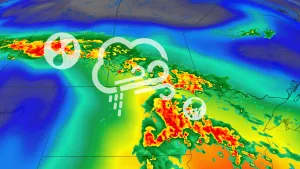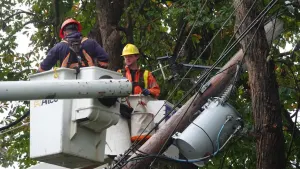
Solar flare triggers geomagnetic storm, leading to auroras in Canada and the US
The lights should be visible in some areas Tuesday and Wednesday from dusk until dawn.
On Saturday, October 9, NASA detected a solar flare that launched a coronal mass ejection (CME) directly at Earth, setting off a geomagnetic storm late Monday.
The storm created the potential for aurora borealis to light up parts of the northern hemisphere between dusk and dawn this week.

Auroras in Alix, Alberta, October 11, 2021. (Dar Tanner/Twitter)

Auroras in Banff, Alberta, October 11, 2021. (Conner Nuspel/Instagram)
On Monday, social media lit up with stunning videos of dancing lights captured in skies across western Canada and the territories.
If clouds don't get in the way, people in northern-tier U.S. states, like New England and Washington, and our friends in western Canada, have additional chances to glimpse the lights Tuesday and Wednesday.

Auroras as seen in Yellowknife, NWT, October 11, 2021. (Matt Jacques/Twitter)

Auroras seen over Manitoba, October 11, 2021. (Dylan Bertholet/Instagram)
"Auroras are typically only a regular sight in the night sky in northern regions of Canada and Alaska. During a geomagnetic storm like we had on Monday night, they can stretch all the way down to the Canada/U.S. border, and can be seen across nearly the entire country and even from the northern United States," says Weather Network meteorologist and science writer Scott Sutherland.
Alongside the auroras, the flare may produce other occurrences as well, including power grid fluctuations and radio interference.

Auroras as seen in Iqualuit, Nunavut, October 11, 2021. (Elisapee Nowdluk/Twitter)

Auroras as seen over Saskatchewan, October 11, 2021. (Craig Hilts/Instagram)

Auroras as seen in Melville, Saskatchewan, October 11, 2021. (Tracy Kerestesh/Twitter)
WHAT ARE THE NORTHERN LIGHTS?
Northern lights, or aurora borealis, occur when solar particles collide with the Earth's atmosphere, NASA says. Their colour variety results from the presence of different types of gas particles in the atmosphere as well as the wavelength of emitted light.
Two of the most common elements in the Earth's atmosphere are oxygen and nitrogen. Oxygen is responsible for green and yellowish-green auroras. Blue, purple and reddish-purple auroras are rare in comparison and are created with the help of nitrogen.










